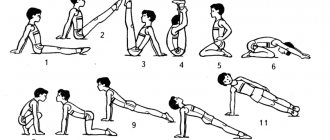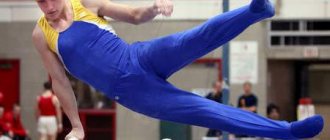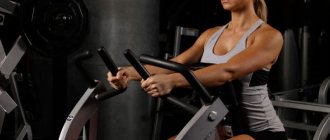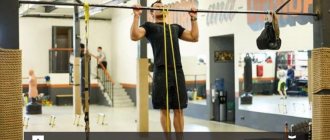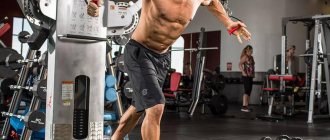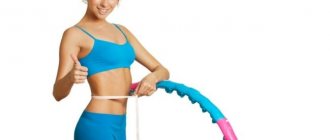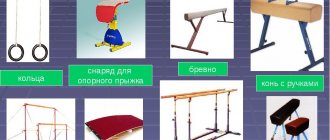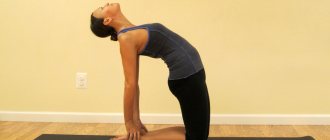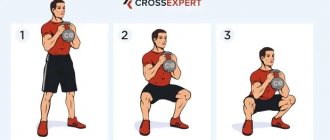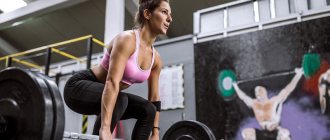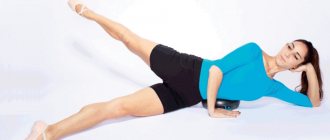Impact on the body
Like other gymnastics exercises, jumping over a support (horse or goat) comprehensively trains all the muscles of the body. In addition to large muscle groups, they affect small stabilizer muscles and develop joint flexibility. With the right approach, this exercise can become an important part of the training process.
Many trainers also consider jumping jacks as a cardio activity, as the run-up causes a sharp increase in heart rate. This has a positive effect on the body and tones the cardiovascular system.
Training in performing exercise No. 15 “Split leg jump over a goat in length”
The process of learning to jump legs apart over a goat in length is divided into three stages: familiarization, unlearning, training (improvement).
Familiarization
is aimed at creating in students a correct idea of the exercise being learned and a clear understanding of its structure.
To get acquainted you need:
- name the exercise in strict accordance with NFP: “Exercise 15. Split leg jump over a goat in length”;
- demonstrate the exercise in an exemplary manner in person (recommended for the unit commander) or with the involvement of one of the unit’s sergeants (a soldier from among the trainees who has been trained in advance and performs the exercise well). The demonstration must be consistent, clear and precise, at a set pace, so that the students have a complete understanding of the exercise as a whole.
The exercise is performed in conjunction with all commands and reports.
During the demonstration of the exercise, students must be on the side of the apparatus in order to see the demonstration of the exercise in profile.
In the case of a personal demonstration, the leader commands himself;
Explain the technique of performing the exercise and its purpose. The explanation of the technique of performing the exercise elements is carried out concisely, without unnecessary details.
The attention of the trainees is focused only on the most significant, in the opinion of the leader, details of the technique and elements of connections or combinations, on which the quality of the exercise largely depends
It should be noted that the main purpose of the exercise being studied is to develop dexterity and fearlessness in students. In addition, performing this exercise for cadets of military educational institutions can serve as a preparatory stage before learning the exercise “Split leg jump over a horse in length” and the exercise “Jump with legs bent over a horse (goat) in width.”
The leader explains that exercise 15 “Split leg jump over a goat in length” for certain categories of military personnel can be included in the list of exercises submitted for testing (current control, intermediate or final certification), as a tested agility exercise;
show the exercise again in parts with an accompanying explanation of the technique. The exercise is shown with a stop in the push-off positions from the bridge and after landing. It is advisable to show students the place of support with their hands on a gymnastic apparatus and, at the same time, explain the technique of performing each element.
Unlearning
is aimed at developing new motor skills in students and improving the technique of performing the exercise.
Due to the fact that the long leg jump over a goat is a physical exercise, although difficult for students, however, performing it in elements (parts) is impractical, so learning the exercise is carried out as a whole.
If, when checking the execution of the exercise (during the first jump), individual students make mistakes, then the next few jumps must be performed over a goat 100 centimeters high; then the height should be gradually increased to 110, 120 and finally to 135 centimeters.
Help in learning the exercise is provided only to those students who have difficulty performing the exercise.
No help is provided to those who know how to jump over a goat; the leader’s attention in this case is directed to monitoring the correctness of the exercise. When learning, special attention is paid to the position of the body, placing the arms on the support, the position of the legs in flight and landing.
When learning, special attention is paid to the position of the body, placing the arms on the support, the position of the legs in flight and landing.
Training
(improvement) is aimed at consolidating motor skills in students, improving physical and special qualities. Training consists of repeating an exercise many times with a gradual complication of the conditions for its implementation and an increase in physical activity.
The main method for developing physical qualities in trainees during training for long straddle jumps over a goat is the repeated method.
It is characterized by repeatedly performing a jump over a goat in accordance with the description of the technique for its implementation. The duration of rest between approaches to the apparatus in this case should be 1-2 minutes.
The method of organizing military personnel when performing long straddle jumps over a goat at all stages of training is in-line, one person per apparatus.
The disadvantage of the flow method is the long wait for your turn to perform the exercise. This expectation increases the more students there are in the group.
Leap onto the bridge
The pounce must be done when reaching maximum acceleration. Many beginners make the mistake of slowing down right before jumping onto the bridge. This automatically worsens the technique and spoils the final result.
Usually the projectile and the bridge are 1 meter apart. This distance may increase or decrease depending on the take-off speed. When jumping onto the bridge, the body should be slightly tilted forward. Both legs need to be moved beyond the line of the body and connected together. Then you need to push off and touch the bridge. At this moment, your hands should be down.
Standing long jump technique
Desire alone is not enough to learn how to jump effectively. First you need to learn the technique of long jump from a place or from a run.
Preparation before take-off
Taking the starting position is an important stage that allows you to concentrate and concentrate all your strength. Unlike the running long jump, here the initial phase is the starting line.
That is, it is necessary:
- with your feet shoulder-width apart, stand at the starting point;
- move your arms slightly behind your back (back), and lower them down with your elbows bent;
- bend the hip and knee joints at the level of the socks;
- fix your feet without lifting them off the ground.
Repulsion
The first repulsion should occur immediately after preparation. If you delay your readiness at this stage, then you will no longer be able to perform a long jump correctly from a standing position. Indeed, at this moment the torso begins inertial movement.
At the same time, during the shock period you need to have time to:
- make a sharp lunge with your hands in front of you;
- tighten the hip joints;
- straighten your legs (knees) at the joints;
- rise sharply from the ground.
Preparation before execution: warm-up
Preparation is divided into two types - direct mastery of the technique of performing a vault, as well as warming up before performing the movement.
To improve and master the technique, a number of exercises are performed:
- Mastering the run-up - an athlete learns to perform a run-up. To do this, elements such as running in place (with a high hip lift), without with variable acceleration, imitation of arm movements, and others are performed.
- Jump onto the bridge - a series of jumps is performed while holding the projectile, at a height, on one leg.
- Mastering flight after take-off - performed with a partner or landing on mats.
- Push - jumping out of place, with a slight run-up, jumping back, pushing off with hands while standing against the wall.
- Mastering flight and landing - a series of jumps at different heights, half-squats and other exercises are used.
The immediate warm-up before performing the exercise includes a full range of movements. It starts with the hands, neck and shoulders with a gradual decrease until the feet are warmed up. Read more about warming up →
Stretching at this stage is excluded, as it can negatively affect not only performance, but also the risk of injury.
Benefits of exercise
Despite its simplicity, an unsupported or supported jump provides a number of advantages. In artistic gymnastics, their mastery is mandatory, since jumps are among the basic and competitive elements.
Main benefits:
- Strengthening tendons and ligaments.
- Involvement of all muscles of the body.
- Development of movement coordination.
- Increased agility and body control.
- Preparing the musculoskeletal system to perform powerful and fast movements (including landings with strong shock absorption).
- Developing courage and determination to overcome assigned sports challenges.
In general, the vault over the goat is used as a springboard for the physical and technical development of more complex elements.
Flying and touching the projectile with your hands
During the flight phase, the athlete swings his legs back and extends his torso. This prepares the pelvic joints for rapid flexion during the subsequent thrust.
The push includes 3 stages:
- Placing your hands on a support (the surface of a horse or goat).
- Receiving a blow with bending of the elbow joints and sagging of the shoulders.
- An active push during which the shoulders move upward, the arms straighten, and the wrists flex.
It is important to combine the push with the arms and the jerk of the body. This will lift your pelvis and stop your legs, allowing you to fly higher.
Types of horses for gymnastics
A gymnastic goat is a special apparatus with handles on which athletes perform a set of swinging and rotational movements, as well as handstands. There are several types of goats:
- jumping;
- flywheel, which differs from the jumping one in that it has special supports (handles), the distance between which is adjustable by 10 centimeters;
- universal with removable handles.
Flyhorse
Horseback competitions are held exclusively among men and are considered a type of team and individual all-around, and are also distinguished as a separate discipline.
The structure includes:
- body made of wood or plastic, with rounded edges and corners. The top of the case is covered with foam and a cover made of artificial high-strength leather. The coating is used to reduce pain in athletes.
- There are four stationary legs.
- Four legs (hooves) that can be extended.
- Pair of symmetrically located handles.
- Elements for attaching the projectile to the floor.
The International Gymnastics Federation puts forward the following requirements for a horse used in competitions, such as:
- the length of the projectile is 160 centimeters;
- width is 35 centimeters;
- height from the floor – 115 centimeters;
- handles 12 centimeters high;
- the diameter of the handles is 3.4 centimeters;
- handles are installed at a distance of 40-45 centimeters;
- The height of the mats is 10 centimeters.
Flight after a push
The flight stage is one of the most important for a gymnast, as it largely influences the final assessment of the performance by the judges. The position of your body in flight depends solely on what type of jump you are making. Immediately before landing, you should straighten your body and tense your legs as much as possible.
Landing is done on your toes, and you must immediately stand on your foot. If you don't do this, you may lose your balance and fall. To soften the blow, you can try bending your legs slightly. A hard landing can lead to pain and injury.
Jumping over a gymnastic apparatus is a classic exercise from artistic gymnastics. It develops the entire body evenly, improving flexibility and balance. If you perform jumps regularly and correctly combine them with strength training, you can achieve good athletic performance and harmoniously develop your body.
Source
Preparation for jumping
The technique of performing a goat jump is quite simple, but in order to feel confident, ideally it would be good to practice the exercises on mats or soft poufs up to the pelvis line.
Do not forget that all jumps must first be secured - supported by the arm and torso. The most dangerous possible situation is when a person falls backwards. There should also be mats laid on the side for safety.
So, we start from the simple and move towards the complex so that the jump over the goat itself becomes just one of the stages of the exercise cycle.
First, try jumping onto the mats with your knees a few times while standing next to them and supporting yourself with your hands. Next, we jump up and land with our knees bent on our feet.
Secondly, we repeat these two exercises, but with a slight run-up. The goat jumping technique involves landing on two feet before pushing off from the bridge. Each time, try to land a little further than the previous time. Even more difficult, but also as safe as possible, since we are dealing with soft mats, is to carry your legs under you and sit down. If you can’t do this exercise, try jumping with your legs apart, but have time to remove your hands so as not to land on them.
When all the previous actions with mats have been mastered, try to jump over them and land on your feet, running up a little faster. At first, you may only be able to sit on the other side of the mats with your legs dangling - no big deal - this is another intermediate option for preparing for goat jumps.
Next, we place a bridge in front of the mats. Leaning on your hands, jump on it several times, pushing off with your feet, to get used to it. Then start landing on the mats with your knees and then your feet.
The next step is to train jumping, that is, running and landing with both feet on the bridge. There is no need to run onto the bridge; it only serves as a springboard for making a jump. Start with two or three running steps. But it’s possible from one.
After the above actions on the mats, we jump over the gymnastic goat. To overcome the fear of jumping, we also start with simple exercises. Leaning on the goat, place your hands on top, not on the sides, press them tightly and jump well on the bridge. To land your knees on the machine, place your hands a little further. Repeat these jumps several times. If they turn out well, try to stand on the goat with your feet, pushing off well from the bridge: jump, stretch out to your full height, walk along the simulator and jump off. This way you get used to all the actions that can be performed with the projectile.
Now you need to jump onto the goat with your feet from a short run, walk along it and jump off. If you do well, practice sitting on the goat, also pushing off the bridge with your feet. Your hands should feel the emphasis; to do this, you need to push off from the machine with them.
The technique of jumping over a goat suggests that it can be performed in two ways: when the legs are bent and pulled towards the chest and when they are spread apart. There is also a third option - a jump - a flip, when the gymnast leans his hands on the apparatus and somersaults in the air and also lands on his feet. But this option is the most complex and not very common. Let's consider the first two options.
Pre-warm-up
The purpose of the warm-up is to prepare the muscles and ligaments for the load. Before starting class, it is recommended to walk around the room. First, do normal walking, periodically changing the pace, then walk on your toes and heels, and run a few circles.
Once you've warmed up your legs, move on to other muscles. Turn your head and body, bend back and forth, and rotate your joints in different directions. Often the warm-up time corresponds to the time spent on training, and sometimes even exceeds it.
For those who are familiar with gymnastics and have been jumping for a long time, there is a faster and more intense warm-up option. It involves several series of jumps, each of which must be performed for 30–60 seconds. To begin with, you should jump in place, trying to touch your chest with your knees. After this, you need to make transitions from lying position to sitting position.
Hyperextension - execution technique
First you need to adjust the height of the machine so that it fits your height.
It is important that the front bolsters are located where the fold will be between the lower back and the upper thighs. As for the lower rollers, they should be placed so that they are above the Achilles tendon. There is a diagram on how to do hyperextension correctly:
There is a diagram on how to do hyperextension correctly:
Sit on a special bench face down, fixing your shins under the bolsters. Keep your torso straight as shown in the figure. You can hold your hands behind your head, but do not clasp them together as this will put unnecessary strain on your neck. Another option for the position of your arms is to cross them over your chest. Advanced athletes can pick up a barbell plate and hold it to their chest. As you inhale, slowly lean forward, but do not round your back, but keep it straight. You need to bend down until you feel a stretch in the back of your thigh. Another signal that you need to stop is the inability to continue moving without rounding your back. As you exhale, lift your body to the starting position
It is important not to do anything abruptly, as this can lead to injury.
There is lateral hyperextension, which helps to work the oblique abdominal muscles. The bench should be installed at an angle of 20-45 degrees.
- Assume a lateral position, securing the outer part of your foot under the bolsters.
- Keep your upper hand behind your head and the other on your stomach.
- Lower your body down to feel the stretch in your side muscles. Hold for a couple of seconds and return to the starting position.
Takeoff run
The take-off run should be carried out with gradual acceleration. Sudden changes in speed can negatively affect the quality of the jump. In professional gymnastics, the running speed can reach 8 m/s.
Take the starting position from which you usually start running. Don't start too quickly. Your movements should be smooth and natural. The length of the distance depends on a number of factors, including:
- projectile type;
- type of jump;
- level of sports training.
For beginners, the running distance is approximately 10 m. The running technique is the same as for sprinting.
Jumping horse
During competitions held under the auspices of the International Gymnastics Federation, a “tongue” or “vault table” is used as a vault apparatus.
The following dimensions of jumping gymnastic goats have been recorded:
- the width of the table for repulsion is 90 centimeters with a permissible error of 5 cm;
- table length is 120 cm with a permissible error of 5 cm;
- table height from 105 to 135 cm.
Phases of the jump
In gymnastics, there are several types of sports jumps. Jumps using a goat or horse are usually classified as support jumps. The gymnastic apparatus itself acts as a support.
The projectile can be installed in length or width. Depending on this, the jumping technique, in particular, the take-off distance, will vary. You can also choose one of the jumping styles - straight or lateral.
The standard technique of jumping over a horse has several stages:
- Run-up (the athlete accelerates before jumping onto the bridge).
- Leap onto the bridge (both feet must land on its springy surface).
- Pushing off with the legs (the elastic push from the bridge gives the body additional acceleration).
- Flight (in fact, this is the beginning of the jump until the moment it touches the support).
- Touching the surface of a horse or goat with your hands (repulsion from the projectile).
- Flight after the push (the final phase of the jump).
- Landing (ideally you want to land with both legs slightly bent and then straighten up).
At first glance, this sequence may seem very complicated. In reality, all stages pass very quickly and smoothly flow into one another. It is important to understand that all phases of the jump are equally important. If inaccuracy is made during any of them, it will ruin the entire exercise. Jumping over a gymnastic apparatus (horse or goat) practically does not differ in technique for men and women.
Vaults require preliminary preparation in the form of active warm-up and warming up of muscles and joints. Failure to comply with this rule can cause injury and severe muscle pain.
What is a gymnastic goat?
This gymnastic apparatus is designed for performing various types of jumps. It consists of a body with different coatings (it can be leather, leatherette, synthetics); installed on 4 metal supports, the height of which can be changed.
Usually there are the following varieties: small (50/32/27 cm) and large (68/36/27 cm) goat. The height of the projectile is adjustable within the range of 85-135 cm. The maximum weight with which you can work on the goat is 100 kg.
Important! Before performing a vault, serious preparation is required in the form of warming up joints, ligaments and warming up muscles (otherwise there is a high probability of injury). Warm-up often lasts no less than the actual workout, and sometimes longer.
